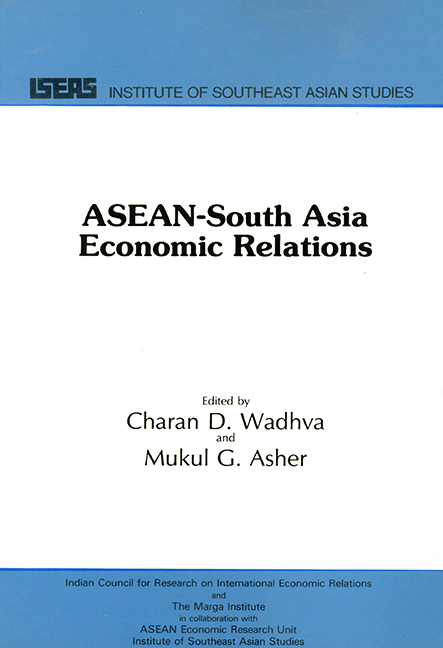Book contents
- Frontmatter
- Contents
- Foreword
- Exchange Rates of ASEAN and South Asian Countries
- An Overview
- PART ONE ASEAN COUNTRY STUDIES
- PART TWO SOUTH ASIA COUNTRY STUDIES
- Bangladesh-ASEAN Trade Relations
- Bangladesh-ASEAN Investment Relations
- India-ASEAN Economic Relations
- Nepal-ASEAN Economic Relations
- Sri Lanka-ASEAN Economic Relations
- Postscript
- Appendix SITC Classification at One-, Two-, and Three-digit Levels
- THE EDITORS
Bangladesh-ASEAN Trade Relations
from PART TWO - SOUTH ASIA COUNTRY STUDIES
Published online by Cambridge University Press: 21 October 2015
- Frontmatter
- Contents
- Foreword
- Exchange Rates of ASEAN and South Asian Countries
- An Overview
- PART ONE ASEAN COUNTRY STUDIES
- PART TWO SOUTH ASIA COUNTRY STUDIES
- Bangladesh-ASEAN Trade Relations
- Bangladesh-ASEAN Investment Relations
- India-ASEAN Economic Relations
- Nepal-ASEAN Economic Relations
- Sri Lanka-ASEAN Economic Relations
- Postscript
- Appendix SITC Classification at One-, Two-, and Three-digit Levels
- THE EDITORS
Summary
INTRODUCTION
Regional economic co-operation among the less developed countries (LDCs) has been receiving increasing attention as a means of achieving “collective self-reliance” in the context of South-South co-operation for promoting a “New International Economic Order”. In line with this is the recently mooted idea for the promotion of an integration scheme in South Asia, where almost a fifth of the world's population lives with a per capita GDP (gross domestic product) of only about US$150 – which is perhaps among the lowest in the world. In the same vein, one can also examine the possibilities and prospects for greater trade and investment co-operation between South Asia and the relatively richer and faster growing neighbouring countries of the Association of Southeast Asian Nations (ASEAN). This study is directed, to a limited extent, towards that end and with particular reference to Bangladesh. Specifically, an effort is made here to assess the current state of trade and tariff co-operation between South Asia and ASEAN in so far as it relates to the position of Bangladesh. This exercise, along with the knowledge on the current investment co-operation (see the paper by Siddiqi in this volume) will hopefully help to identify and formulate selected schemes for strengthening economic relations among the above-mentioned countries.
This study consists of four main sections. In Section II, projections relating to some major components of Bangladesh's balance of payments up to 1990 are presented. An attempt is made next in Section III to analyse the existing trade relations between the two regions with special reference to Bangladesh, providing in particular, a number of measures on trade intensities. Finally, such collaborative measures in the region as the Bangkok Agreement and the Asian Clearing Union are discussed in Section IV. Some observations are also made here on tourism in Bangladesh and on the country's national airlines and shipping facilities.
- Type
- Chapter
- Information
- ASEAN-South Asia Economic Relations , pp. 225 - 252Publisher: ISEAS–Yusof Ishak InstitutePrint publication year: 1985



